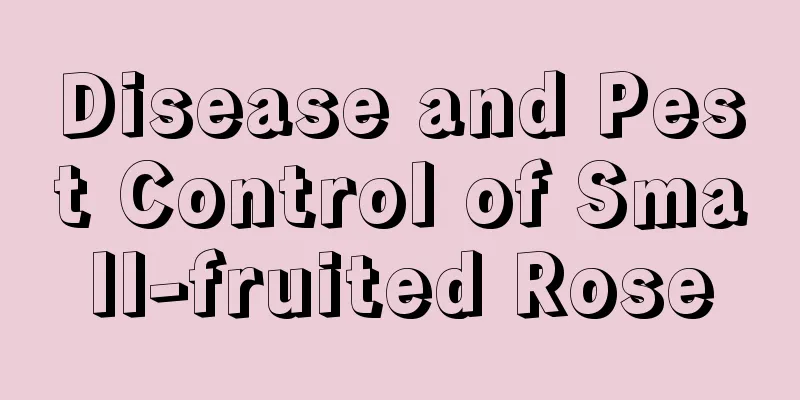Disease and Pest Control of Small-fruited Rose

1. Powdery mildew1. SymptomsThe disease often occurs on leaves (including leaf blades and leaf stalks), flower buds and tender young shoots. (1) Leaf disease: White powdery mildew spots appear on the leaves. The disease usually starts from the tip or edge of the leaf and spreads to the inside in a brown color, causing the entire leaf to dry up and fall off. (2) Young shoots: The chlorosis phenomenon gradually expands the scope of infection, with white powdery spots appearing on both the front and back sides. After spreading to the entire leaf, the leaves turn light gray or dark red, causing the leaves to deform and shrink. (3) Flower buds: The white powdery bacteria will cover the flower buds and pedicels, causing the flower buds to be deformed. Timely treatment is required. In severe cases, the plant will die. 2. Solution(1) To prevent it, you need to ventilate more, provide a good drainage environment, and reduce moisture; (2) Once diseased strips or leaves are found, the diseased parts should be cut off in time during winter pruning to prevent the spread of the disease. (3) During the disease period, attention should be paid to fertilization. Phosphorus fertilizer and potassium fertilizer can enhance the plant's ability to resist pathogens, and nitrogen fertilizer should be applied less. (4) In the early stage of the disease, you can use 20% chlorothalonil (i.e. triadimefon) as a pesticide and spray it in appropriate amounts. You can also use a suspension of 20% triadimefon and sulfur. Since the plant's own drug resistance will have a certain impact on the effectiveness of the agent, we can also use 12.5% amylopectin emulsifiable concentrate instead of the above-mentioned drugs for treatment. 2. Black spot disease1. SymptomsAs the name suggests, black spots appear on the plants, and purple-brown, reddish-brown and small dots appear on the leaves and buds, which then spread to form spots. 2. SolutionSpraying agents: You can use carbendazim, methyl thiophanate, daconil, etc. 3. Anthrax1. SymptomsThis symptom is somewhat similar to black spot. Most of the anthracnose lesions are distributed in a semicircular shape on the edge of the leaves. The lesions themselves transition from light brown to dark brown from the middle to the edge. In the later stage of the disease, small black spots will appear. 2. Solution(1) Try not to place the plant in a tightly humid area, as excessive moisture can easily lead to the production of pathogens. In addition, it is necessary to write on paper in time to prevent the branches from being too dense and affecting ventilation and light transmittance. The diseased and fallen leaves should be pruned and cleaned up in a centralized manner, and it is best to burn them. (2) If the disease is found, drugs such as 75% thiophanate-methyl powder and 20% thiophanate-methyl suspension can be used to kill the virus. 4. Leaf rust1. SymptomsThis disease is relatively common for roses, and the pathogen will invade leaves and new branches, causing leaves to fall or even death, so timely measures must be taken. 2. SolutionSpray 800 times of benomyl (triadimefon) once a week until the symptoms are cured. |
<<: Disease and insect pest control of cymbidium
>>: Disease and insect pest control of tiger orchid
Recommend
How to grow Mirabilis jalapa in a pot
1. Soil It has almost no requirements for soil an...
Does Canna prefer shade or sun?
Does Canna prefer shade or sun? Canna is easy to ...
How to trim the rich tree
When is the best time to prune the sedge The prun...
How to grow the red flower jade quickly
Growth conditions of red flower jade The crimson ...
How to raise pearl birds and precautions
The pearl bird is a popular small ornamental bird...
How to prevent the root rot of copper green unicorn
1. How to prevent 1. Less water: If you don’t wan...
Early Spring Carrot Planting Time and Method
Early spring carrots are carrot varieties that ar...
Layering method for propagating poinsettia
Poinsettia aerial layering propagation time Most ...
Where is the best place to plant pomelo?
Pomelo planting area Pomelo generally grows in wa...
When is the best time to take cuttings of Christmas cactus?
1. Cutting time Generally speaking, spring and au...
How to cultivate Buddha beads Lover's Tears
1. Breeding conditions 1. Potting soil: The Buddh...
Is Aloe Vera poisonous?
1. Is it toxic? In fact, I can tell you for sure ...
How to grow butterfly plum, what to do when the leaves turn yellow
1. Breeding methods 1. Sunlight: It needs sunligh...
No matter how poor you are, you should plant these three kinds of trees in your living room to gather energy and bring wealth.
For example, you can put a pot of plants that loo...
When is the best time to take cuttings of chrysanthemums?
Best time for cutting chrysanthemums Chrysanthemu...









